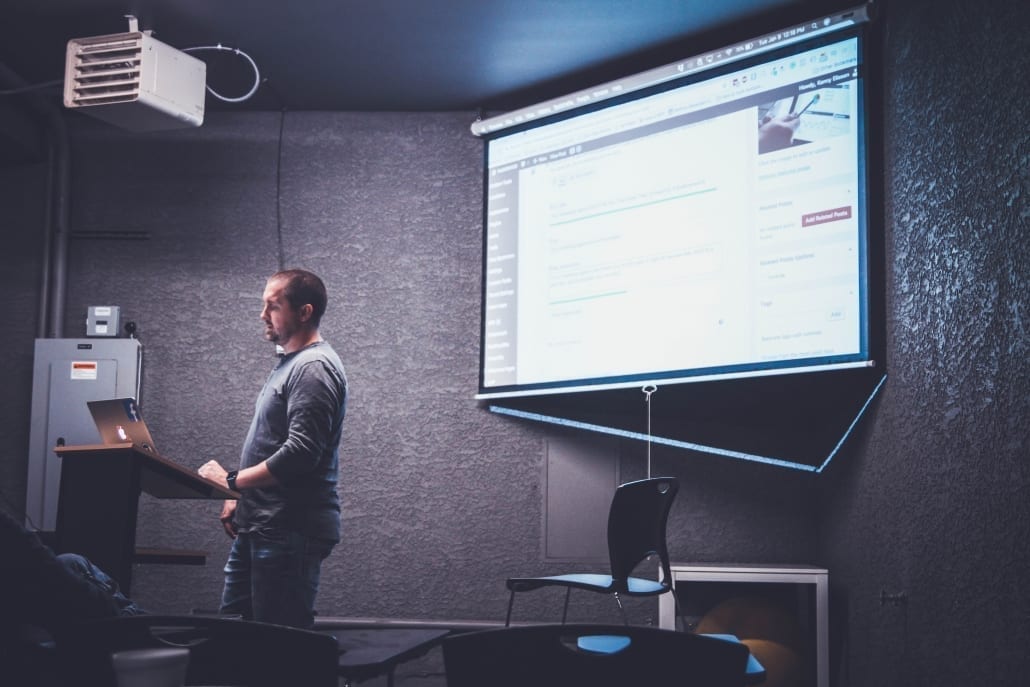Present for Success
 Does this sound familiar? You have a big presentation and you practice reading your notes for several days. You work on the perfect PowerPoint slides and polish your content, but on the big day it feels like your presentation falls flat. What happened?
Does this sound familiar? You have a big presentation and you practice reading your notes for several days. You work on the perfect PowerPoint slides and polish your content, but on the big day it feels like your presentation falls flat. What happened?
If public speaking makes you uncomfortable or gives you anxiety, you’re not alone: public speaking is one of the most common fears in the United States. Unfortunately, that anxiety can interfere with your delivery. It doesn’t matter how strong the content of your presentation is, if you’re unable to speak in a clear, confident manner, your message will suffer. In fact, recent research has shown that how you say something actually matters twice as much as what you say!
Learning to speak with confidence and master the art of public speaking is crucial to professional success. Whether it’s giving a sales presentation, pitching an idea to a committee, or presenting your ideas to a prospect or client, the ability to speak in a clear, engaging and confident manner is a crucial part of advancing your career. In today’s business world it is imperative that we polish our tone, engage the audience and deliver a dynamic presentation; even if it is just to one person.
Ready to take your public speaking skills to the next level? Take a look at these five tips to improve your speaking and presentation skills:
- Always keep water on hand when you speak. I am always surprised to see people stand at a podium or deliver a speech of greater than fifteen minutes and not have an accompanying glass or bottle of water. Speaking for a prolonged period can dehydrate your vocal cords, and dry mouth caused by nerves can make the situation worse. Staying well hydrated will help keep your voice strong and clear. In addition, taking a sip of water can be a great way to take a moment to compose yourself and collect your thoughts during your presentation.
- Don’t forget to breathe! Closing your eyes and taking a few deep breaths before you present is remarkably effective for helping you to calm down and focus on the task at hand. Take a moment and breathe in through your nose and out from your mouth several times before taking the stage or podium. Taking deep breaths from your abdomen as you speak helps you retain this calm, and also gives power to your voice.
- Before you begin, take two minutes to do some vocal warm-up exercises. They’ll help to relax you and make your speech more fluid. This is even more important if you are giving a morning presentation and have not yet conversed with colleagues; you literally need to “warm-up” your voice! Lip flutters and humming are two simple and effective ways to warm up, and sliding your voice from its highest to lowest speaking pitch can prepare your vocal cords to use the range you need for a dynamic, engaging speaking voice.
- Improve your clarity. When people get nervous they tend to rush the delivery of their message, which subsequently causes mumbling. When people swallow their words or mumble, the importance of the message can be lost. Focus on saying each sound, especially at the ends of words.
- Practice! If you’re completely confident in the content of your presentation beforehand, you’ll be much more relaxed, and free to focus on the quality of your speech and your presentation style. Once you’re confident in what you are going to say, put in some additional practice time focusing on your performance style. If you incorporate clear speech and a dynamic voice into your practice, it will come much more naturally on the big day.
Polishing your public speaking skills will help you to gain confidence and increase your professional credibility. Take the time to focus on your speaking style, and make sure your presentation is doing your message justice. Remember: It’s not just what you say, it’s how you say it!
About the Author

If you are interested in learning more ways to improve your business communication skills, contact Jayne at info@corporatespeechsolutions.com or visit www.corporatespeechsolutions.com.

 Visionary and lauded business accelerator Michelle Patterson is President of the Global Women Foundation and
Visionary and lauded business accelerator Michelle Patterson is President of the Global Women Foundation and 
 Leadership authority Roxana (Roxi) Hewertson is a no-nonsense business veteran revered for her nuts-and-bolts, tell-it-like-it-is approach and practical, out-of-the-box insights that help both emerging and expert managers, executives and owners boost quantifiable job performance in various mission critical facets of business. Through
Leadership authority Roxana (Roxi) Hewertson is a no-nonsense business veteran revered for her nuts-and-bolts, tell-it-like-it-is approach and practical, out-of-the-box insights that help both emerging and expert managers, executives and owners boost quantifiable job performance in various mission critical facets of business. Through  Question:
Question: Power Stars to Light the Business Flame, by Hank Moore, encompasses a full-scope business perspective, invaluable for the corporate and small business markets. It is a compendium book, containing quotes and extrapolations into business culture, arranged in 76 business categories.
Power Stars to Light the Business Flame, by Hank Moore, encompasses a full-scope business perspective, invaluable for the corporate and small business markets. It is a compendium book, containing quotes and extrapolations into business culture, arranged in 76 business categories.